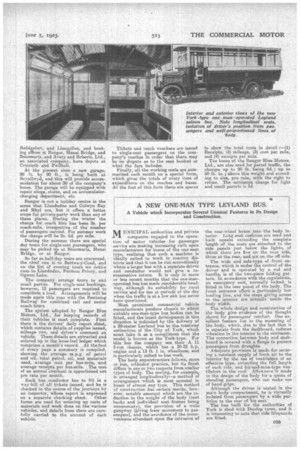A NEW ONE-MAN TYPE LEYLAND BUS.
Page 39

If you've noticed an error in this article please click here to report it so we can fix it.
A Vehicle will& Incorporates Several Unusual Features in Its Design and Construction.
MIJNICIPAL authorities and private companies engaged in the operation of motor vehicles for passenger service are making increasing calls upon manufacturers for .buses of the one-man type, realizing that such a machine is ideally suited to work in country districts and that it can be run economically where a larger bus with a separate driver and conductor would not give a remunerative return. It is only in more or less recent months that the one-manoperated buts has made considerable headway, although its suitability for rural service and for Use at periods of the day when the traffic is at a low ebb has never been questioned. Most, prominent commercial vehicle manufacturers produce chassis to whiele suitable one-man-type bus bodies can be fitted, and the latest development in this direction is indicated by the delivery of 210-seater Leyland bits to the tramway authorities of the City of. York, which must take it as a compliment that the model is known as the York-type. For this bus the company use their A a 2-ton chassis, which has a 30-32 h.p. engine and a 13 ft. 1 in, wheelbase, and is particularly suited to bus work.
The body superstructure fellows, more or less, orthodox practice but its finish i differs n one ortwo respects from similar types of body. The seating, for example. is arranged longitudinally—a method of arrangement -which is 'nest unusual in buses of almost any type. This method of construction has certain merits, however, notable amongst which are the reduction in the weight of the body (seat backs and individual seat frames being unnecessary), the provision of a wide gangway (giving freer movement to passengers), and the avoidance of the inconvenience attendant upon the intrusion of the rear-wheel boxes into the body interior. Long seat cushions are used and back squabs extending the complete length of the seats are attached to the side panels just below the lights, of which there are five on the near side, three at the rear, and six on. the off side.
The wide and safe-type of front en trance, which is under the control of the driver and is operated by a rod and handle, is of the two-piece folding pattern. In accordance with the regulations, an emergency exit, normally locked, is fitted in the rear panel of the body. The front entrance offers a particularly low • loading line, and the steps giving access to the interior are actually inside the body width.
The whole design and construction of the body give evidence of the thought shown for passengers' comfort. One excellent feature lies in the mounting of the body, which, due to the fact that it is separate from the dashboard, reduces Vibration in the interior to the minimum. The connection between body and dashboard is covered with a flange to protect passengers from draughts. Adequate provision is made for emir.
ing a constant supply of fresh air to the interior by the use of ventilatcirs of an effective type, extending the full length of each side, and hit-and-miss-typo ventilators in the roof. Allowance ls made in the design of the body for a quota of standing passengers, who can make use
of hand-grips. . Although the driver is seated in the main body compartment, he is virtually isolated from passengers by a wide partition to the rear of his seat.
The bus built for the authorities of York is shod with Dunlop tyres, and it is interesting to note that side lifeguards are fitted. . •








































